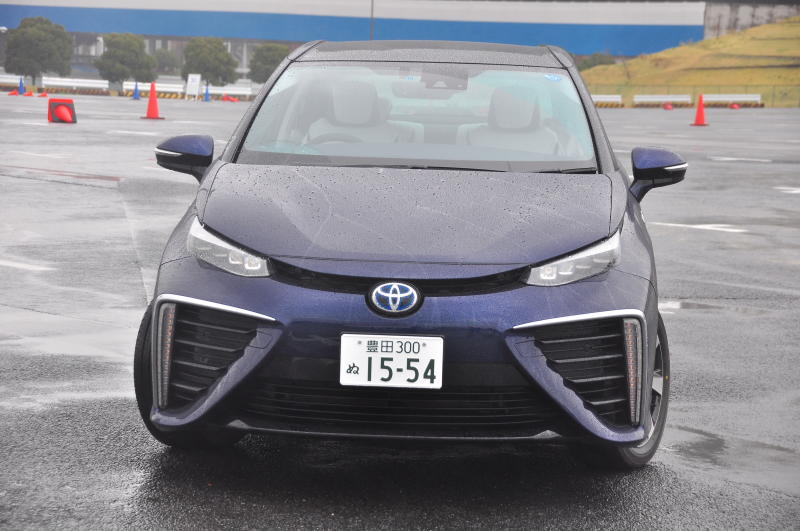IT’S not about clairvoyance when we talk about the future because in this case we literally had the opportunity to not just take a peek, but sample what Toyota is banking on to be the future of mobility - the Mirai.
The Japanese word mirai means “future” and Toyota is offering this hydrogen-powered Fuel Cell Vehicle (FCV) sooner than some may have anticipated.
You see, the water-producing Mirai is not just ready for production, better yet, it’s ready to go on sale - try early this year in California, where 17 more stations will be built with an additional 28 next year.

The Mirai is Toyota’s solution to carbon-dioxide emissions, pollution, global warming, our dependence on fossil fuels and the fluctuation of crude oil prices.
So off we were whisked to the land of the rising sun, where we were greeted by gloomy skies, rain and strong winds with temperatures ranging between zero and nine degrees Celsius.
It was a cold and extremely wet morning as journalists gathered at a large vacant carpark, just outside of DiverCity Tokyo Plaza, where the Mirai awaited.
The Mirai’s styling is definitely a “one-of-a-kind”, though it was designed to be as aerodynamic as possible, but its styling cues could do with a revision or two, to say the least.

As they say, beauty is in the eye of the beholder, but unfortunately, the Mirai’s design doesn’t seem to agree with many.
For one, the front left and right air intake grilles simply overwhelm the squinty LED lights and its muscular rear haunches and bulky rear-end helps to belittle the Mirai’s 17-inch aluminium wheels.
But this is a mode of transportation that’s going to revolutionize mobility and industry; not just helping to rid our earlier mentioned dependencies, but also address the issues of range and recharge times faced by electric vehicles (EV).
How far can the Mirai go?
About 481km according to Toyota, and it’ll take just three minutes to fully fill its two tanks - 62.4 litres just before the boot and 60 litres under the rear sofa seat, for a combined capacity of 122.4 litres (5kg) worth of hydrogen.
To create an electrical charge, the compressed hydrogen is sent through a platinum-coated membrane that separates its electrons and protons - the electrons are delivered to the electric motor while the protons mix with the air and voila - water is produced as a by-product.

Toyota employs a newly-designed high-pressure (700 bar) tank that’s 40% stronger than conventional ones and splits the storage for better weight distribution.
The tanks utilise a plastic liner to seal in its hydrogen content while a carbon fibre-reinforced plastic layer encases it to provide better pressure resistance with another layer of glass fibre-reinforced plastic layer added over it for a little more protection.
With the added strength, the thickness of the tank’s wall has been reduced by 15mm - from 40mm to 25mm, thus reducing the initial number of tanks from four to two.
Although a little thinner, Toyota was quick to indicate that they’ve crash tested these tanks up to a speed of 80kph and were happy to report that there were no fractures or any form of deformation found on the tanks.
In terms of cost, it’s also more affordable compared to earlier systems - thanks to a reduction in expensive exotic materials and parts used.

The Mirai is still equipped with a small nickel-metal-hydride battery pack, but that’s just for storing an electrical charge from its regenerative braking system and can be used to aid in acceleration.
Inside, The cabin is comfortably spacious, providing plenty of shoulder, head and leg room, which is just a little more than a Camry’s.
Inside, attention is drawn towards the centrally-mounted high-definition 4.2-inch LCD display, located just below the central meter cluster and its highly polished touch panel that’s simply a magnet for fingerprints and dust.
We weren’t able put the Mirai’s impressive range to the test (being in a carpark and all), but instead it was an opportunity to experience some of its performance.
From a standing start, flooring the accelerator will deliver the electric motor’s 150bhp and 335Nm of torque to the front wheels with urgency (even with a kerb-weight of 1,850kg), much like a battery-equipped EV would perform.
According to Toyota, the Mirai’s silent 0-100kph sprint takes just over 9 seconds before reaching a top speed of 180kph, but unfortunately we weren’t able to test that out either.
However, during acceleration there’s some whine tip-toeing its way into the cabin, in addition to some tyre noise, but other than those it’s a silent affair thanks to the double-paned windows that’s usually found in Lexus models to help rid wind-noise.

Following the short accelerative burst, its was hard on the brakes before a tight right turn on the thoroughly wet miniature course, but drama was no where to be seen.
Instead, we were surprise to note the firm suspension and lack of roll from the left-right chicane that was followed by a left hair-pin turn - allowing the Mirai’s rigid chassis and firm-yet-comfortable suspension to shine.
For obvious reasons, Malaysia will not be getting the Mirai any time soon, not till we begin building refilling stations, but we do have plants that dot the country producing the gas, so it may take a while till we see both the car and a refilling station.
The Mirai should not be judged like a book’s cover.
But this vehicle should be recognised for its abilities to address environmental, economic and technological issues.
With Toyota’s confidence and abilities in hydrogen technology, it’s currently an exciting point in time as we could potentially witness fossil-fuels begin its fade-out to make way for a new era in mobility — a hydrogen one.































